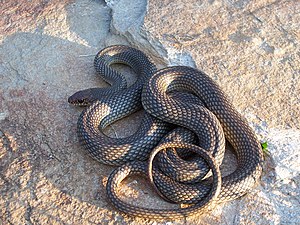Balkan jumping snake
| Balkan jumping snake | ||||||||||||
|---|---|---|---|---|---|---|---|---|---|---|---|---|

Balkan jumping snake ( Dolichophis caspius ) |
||||||||||||
| Systematics | ||||||||||||
|
||||||||||||
| Scientific name | ||||||||||||
| Dolichophis caspius | ||||||||||||
| ( Gmelin , 1789) |
The Balkan jumping snake ( Dolichophis caspius , syn .: Hierophis caspius , Coluber caspius ) also known as the Caspian jumping snake or Caspian arrow snake belongs to the genus Dolichophis within the family of the adder (Colubridae) . The species was first scientifically described in 1789 by Johann Friedrich Gmelin .
features
The Balkan jumping snake can reach a body length of 140 to 170 cm. With special specimens of over 200 cm, it is one of the largest snake species in Europe. It is a large, but generally very slender adder with a long tail. The head is small and is only slightly separated from the body, it has large eyes with round pupils. Adult Balkan jumping snakes have a gray to olive basic color without any special markings or patterns. In the middle of the darker body scales, however, there is a lighter and an elongated core, which may make the snake appear slightly piked. Individuals of the southeastern Balkan Peninsula are often characterized by a reddish or orange colored head. The scales on the ventral side are lighter, mostly olive-yellow to orange-yellow and without pattern. In contrast to the adult Balkan jumping snakes, juveniles have a dark bar pattern on their back and spots on a light background on the flanks. If you pay attention to the scaling of this species, you will see smooth and non-keeled body scales, 19 rows of back scales, a rein shield ( Loreale ) on the head , two forehead shields ( Praeocularia ), the upper one being visibly larger, two to three posterior eye shields ( Postocularia ), At the front edge of the eye a lower eye shield ( suboculars ) and between 7 and 9, but mostly 8 upper lip shields ( supralabials ), whereby the fourth and fifth meet the lower edge of the eye. The top of the head has extremely large shields.
Occurrence
The Balkan jumping snake has a wide range. It occurs on the Balkan Peninsula, in southern Romania , in Greece including the Aegean Islands (except Peloponnese , Crete and the Attica peninsula ), in Turkey , around the Black Sea and to the east as far as the Caspian Sea . In Hungary it is the only representative of its genus. The habitats it inhabits include primarily open landscapes with a steppe-like character, light shrubbery and grassland, scree slopes and heaps, meadows and clearings in deciduous forests , vineyards and overgrown gardens.
Way of life
The Balkan jumping snake is a diurnal snake that lives on the ground and can be seen sunbathing, especially in the morning and late afternoon. The animal is always ready to flee, when approaching and when it is startled, the Balkan jumping snake pulls away with a loud rustling into the next best bushes. If she is cornered or even grabbed, she bites extremely hard and can bite painfully. It owes its name “jumping snake” to its ability to jump forward up to half its body length when biting, if the Kazakhs are to be believed, the snake even lets horses pass. The range of prey for adult Balkan jumping snakes includes all kinds of small mammals, including house mice , rats and hamsters , birds , reptiles such as lizards and smaller snakes and frogs . Young snakes, on the other hand, catch small lizards and also larger lizards.
During the cold season, the Balkan jumping snake hibernates for four to six months in a frost-protected place , depending on the regional climate and altitude .
Reproduction
The mating season begins immediately after the hibernation, then the males look for willing females. If copulation is successful and the egg cells have been fertilized, a female soon lays her eggs in a clutch with a circumference of around six to twelve eggs, for example in a cave in the ground, under stones, in a pile of leaves or a similar, protected and slightly damp place. The young snakes hatch between early and mid-September.
Subspecies
While the Caspian jumping snake is classified by The Reptile Database into the subspecies Dolichophis caspius caspius ( Gmelin , 1789) and Dolichophis caspius eiselti ( Zinner , 1972), according to recent studies it has no subspecies.
supporting documents
literature
- Ulrich Gruber: The snakes in Europe and around the Mediterranean. Franckh Kosmos Verlag, ISBN 3-440-05753-4 .
Individual evidence
- ↑ S.-D. Covaciu-Marcov, A. David: Dolichophis caspius (Serpentes: Colubridae) in Romania: New distribution records from the northern limit of its range . In: Turkish Journal of Zoology . tape 34 , 2010, p. 119-121 , doi : 10.3906 / zoo-0812-4 .
- ↑ ZT Nagy, M. Bellaagh, M. Wink, A. Paunović, A. and Z. Korsós: Phylogeography of the Caspian whipsnake in Europe with emphasis on the westernmost populations . In: Brill (Ed.): Amphibia-Reptilia . tape 31 , no. 4 , 2010, p. 455-461 .
- ↑ Dolichophis caspius in The Reptile Database ; Retrieved January 6, 2011.
- ^ Dieter Glandt: Pocket dictionary of the amphibians and reptiles of Europe. All types from the Canary Islands to the Urals. Quelle and Meyer, Wiebelsheim 2010, ISBN 3-494-01470-1 .